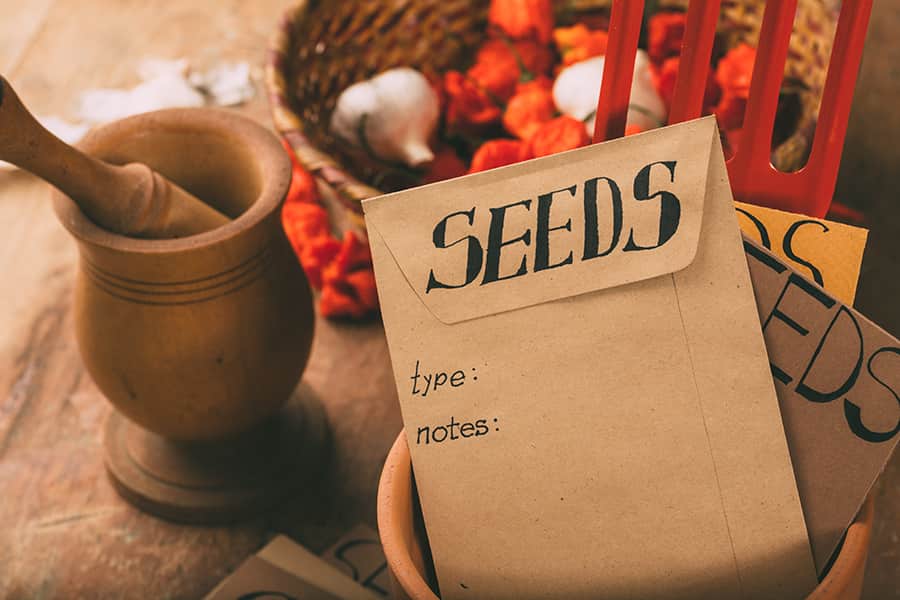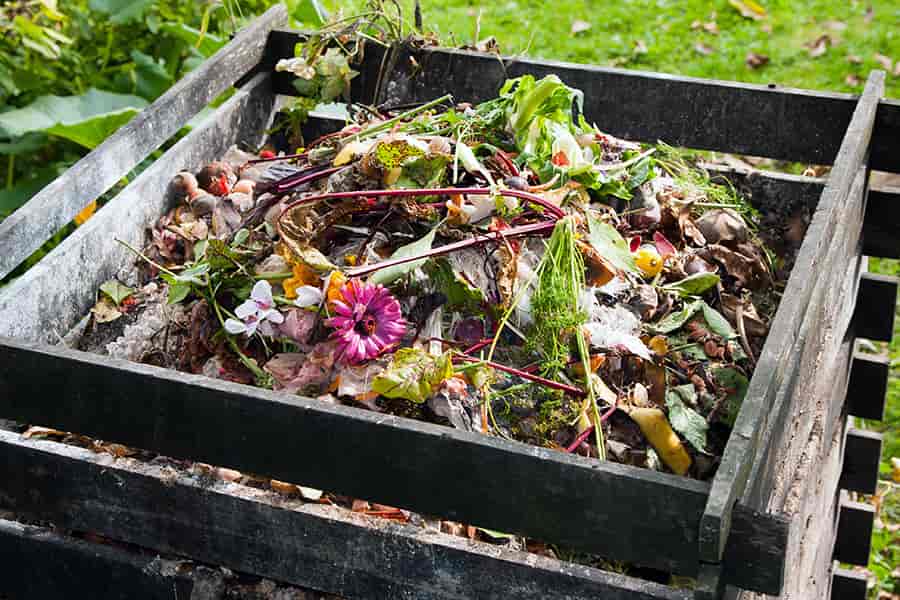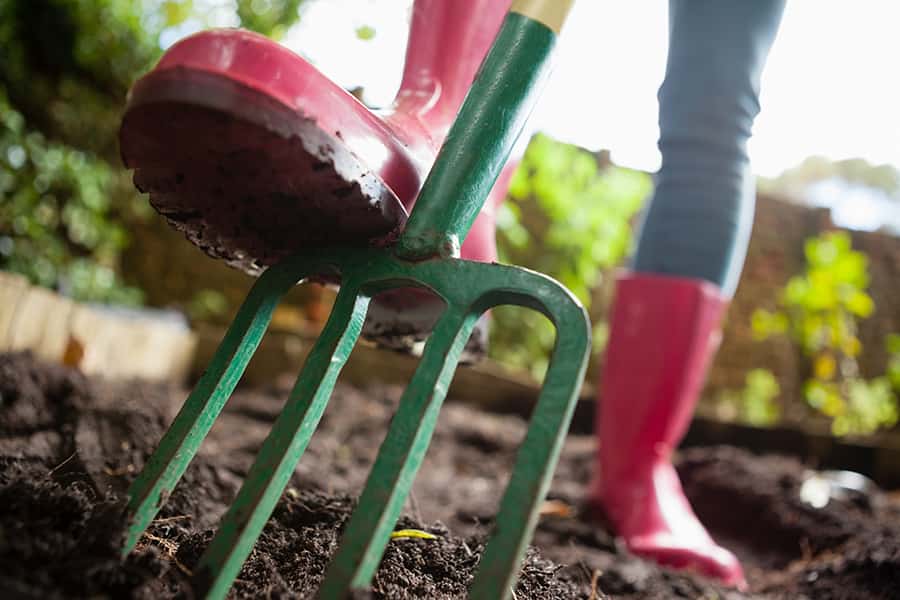- Home
- Leisure & Lifestyle
- Home & Garden
- 13 gardening to do’s this September
September marks the first month of autumn. And with the weather getting cooler and damper, there’ll be plenty of things to add to your gardening checklist.
Early autumn is a great time to prepare your garden for the winter, plan for next year, and tidy up after summer.
With that said, here are 13 jobs to do in your garden this September.
Contents
- Collect seeds
- Divide herbaceous perennials
- Harvest vegetables and plant autumn/winter ones
- Plant evergreen trees and shrubs
- Dig up any remaining potatoes before they get eaten by slugs
- Plant spring flowering bulbs and seeds
- Harvest apples
- Give your lawn some TLC
- Keep an eye on your bird feeder
- Make your own compost
- Clean up
- Turn over your soil
- Water house plants less frequently
1. Collect seeds

September is a great time to harvest ripe seeds from any summer flowering plants that you want to grow again next year. However, it’s important to only harvest seeds from flower heads when they’re hard and brown.
You might find it useful to store them in brown paper bags labelled with the name of the plant, the harvest date, and any other important information, so that they’re ready to sow next spring. It’s also important to make sure the seeds are completely dry before you store them away. If needed, you can place them on a sheet of newspaper to dry out for a few days first.
Storing your little brown packages in an airtight container will help to make sure they stay dry until they’re ready to be sown. If stored correctly, most seeds will be viable for about three years after their harvest date.
To find out more about how to collect and store seeds, check out this handy guide from the Royal Horticultural Society (RHS). The video below will also show you step-by-step how to collect seeds from your garden.
2. Divide herbaceous perennials

Herbaceous perennials are plants that have non-woody stems and reach their full height and flowering potential within one year. They then die back over the winter and reappear in spring.
As the weather gets cooler, dividing your herbaceous perennials will help them to reboot and re-energise – so they return with even more vigour next spring. Some people also divide their herbaceous perennials in order to grow more of their favourite plants.
Plants like to be divided in different ways at different times of the year, so it’s important to check whether September is a good time to divide yours. Salvias, Helenium, Helianthus, and Japanese anemones are examples of perennials that divide well in September.
For more tips on how and when to divide herbaceous perennials, take a look at this guide from the RHS. The video below from Waitrose will also guide you through the process.
3. Harvest vegetables and plant autumn/winter ones

Many vegetables, including peppers, sweetcorn, and courgettes, are ready to harvest in September. This guide from the National Trust has some helpful information about what vegetables are best harvested in September – plus some tasty recipes that you could use them in.
However, while September is a time to harvest some vegetables, it’s the ideal time to plant others. In fact, there are plenty of hardy vegetables that you can plant now and enjoy during the colder weather – and most can be sown or planted directly outside. Onions, garlic, and radishes are popular choices.
To find out what other vegetables you can start growing during autumn, take a look at this article from A.Vogel. You can also buy seasonal boxes containing a range of different seeds on Seed Pantry. If you select Seed Pantry’s Grow Club Discovery Box, you can choose six different seed types from their autumnal collection.
4. Plant evergreen trees and shrubs

Evergreen trees and shrubs are much more likely to establish themselves and survive during autumnal weather, because the soil is warmer and more moist. So if you’ve been thinking about planting evergreen trees or shrubs, this is the month to do it.
For best results, it can help to prepare the soil by adding some nutrient-rich compost to it. You can also protect young trees and shrubs from gusty winds by attaching them to a stake or a cane. The video below will show you how to plant and stake a tree.
If you’re not sure which trees or shrubs to plant this month, olive trees, fig trees, or Japanese Quince are a few good options to consider.
5. Dig up any remaining potatoes before they get eaten by slugs

During autumn, when soil tends to be warm and moist, slugs become far more active – which could put your potatoes at risk.
To keep your potatoes safe, make sure you lift them from the soil as soon as possible. Main crop potatoes are usually ready around mid-September, and leaving them in soil longer can increase your chances of digging up holey, slug-eaten potatoes.. For more information on how and when to dig up your potatoes, check out this helpful guide from Gardening Know How.
Potatoes grown outdoors in autumn will also be more susceptible to blight – a disease caused by fungi. However, potatoes suffering from blight might survive if it’s caught early enough. For further guidance on blight, including how to treat and prevent it, have a read of this article from GardenFocused.
Top tip: Some types of potatoes are more susceptible to slug damage than others. If your soil seems to be popular with slugs, it’s best to avoid Maris Piper, Marfona, or Estima varieties. Instead, opt for Romano, Lady Rosetta, or Pentland Dell, which are less susceptible to slug damage. You could also try growing Wilia, Heather, or Kestrel. These mature early and can be lifted during August before the soil starts to become damp and humid. During a very wet summer, these will need to be lifted as soon as you notice any signs of trouble.
6. Plant spring-flowering bulbs and seeds

If you want a guarantee that you’ll have flowering plants in your garden next spring, you’ll need to plant your seeds and bulbs this autumn so they can start putting down roots. Make sure you choose bulbs that are firm, plump, and free from mould.
Planting bulbs and seeds now will not only save you from spending money on plants during spring – but can also result in healthier plants because they’ll already have had plenty of time to get settled. Plus, it can be incredibly rewarding to know that you’re growing everything in your beautiful garden yourself.
If you’d like to buy some bulbs and seeds, Seed Pantry has a great selection that you can plant in September. As well as seed kits that include growing essentials like labels, compost, and pots, and instructions on how to sow and care for seeds.
English Marigolds, poppies, and cornflowers are examples of flower seeds that can be sown earlier in the month. And daffodils, crocus, and hyacinths are examples of bulbs that are best planted by the end of September.
7. Harvest apples

September marks the beginning of apple-picking season, so get ready to make some room in your fruit bowl. You’ll know whether apples are ready to pick or not because they’ll come away easily if you give them a gentle twist.
Try to harvest apples before they fall to the ground and start rotting or become a tasty treat for wildlife. If any apples do fall, but only have minimal damage, try cutting off the bad bits and using them in a recipe – perhaps a crumble or strudel. Delicious magazine has a huge selection of apple recipes if you’d like more inspiration.
To find out what other fruit is ready to harvest around September time, check out our article; What fruit and vegetables are in season now?
8. Give your lawn some TLC

September can be an ideal time to renovate your lawn because the weather is usually still mild and there’s an increase in rainfall – which can help your grass reach its full potential.
Towards the end of summer, it’s not uncommon for lawns to have an abundance of moss or weeds – often because they’re lacking in nutrients.
But there are a few things you can do to help…
Use a rake to remove any moss or thatch (old grass clippings) that have built up on your lawn and pull out any large weeds by hand.
Continue to mow your grass regularly while it’s still growing (as long as it’s not too muddy). September can be a dewy month, so it’s best to cut your grass during the day to get a straight cut and to avoid your lawnmower becoming clogged with wet grass clippings.
Aerate your lawn to improve drainage. You can do this by making some evenly spaced-out holes with a garden fork.
- Add fertiliser to your lawn. Feeding your lawn during the autumn will encourage strong root growth, help it stay green and healthy, and protect it from frost and diseases during the winter months.
You can buy lawn fertiliser on Amazon and all you need to do is mix the recommended amount of feed with some water in a watering can, and apply it evenly over your grass.
9. Keep an eye on your bird feeder

With the changing seasons comes a change in wildlife, and September can be a particularly busy month. For this reason, it’s worth keeping a close eye on your bird feeder.
Different bird species will have a range of different autumn activities planned that your bird feeder can help with. Some will be eating as much as they can to prepare for a long winter of hibernation, some will be fueling up for a long flight, and others will just be stocking up for a cold and unpredictable winter.
Once you’ve established a feeding routine with birds, try to stick to it, as they’ll become used to it and will visit your garden regularly looking for their next meal. The RSPB have some useful tips on what to feed birds and how you can keep your feeding station hygienic and pest-free. You can also pick large bags of bird feed up for a few pounds from Wilko.
Fun bird-watching facts...
- During the autumn, we say goodbye to birds that have been visiting during the summer – including the Willow Warbler which flies all the way from the UK back to Africa! These tiny birds mostly eat fruit and insects during summer, so they don’t visit feeders often, but you might see an appearance during the autumn when they start stocking up on nuts and berries to prepare for their 5000-mile journey back to sub-Saharan Africa.
- Once Willow Warblers and other summer visitors have left for the winter, we receive a whole new flurry of bird species who come from much colder regions including Scandinavia and Russia and stay with us over winter. These birds include the Redwing, Waxwing, and Fieldfare – so have a look out for them over the coming months.
If you’re interested in birds and would like to know more about how to spot them, or how to attract more to your garden you might be interested in our articles; A beginner’s guide to bird-watching and 11 ways to make your garden more wildlife friendly.
10. Make your own compost

It takes about six months to make your own compost, which makes autumn a great time to get started because it’ll hopefully be ready for spring planting. Making your own compost allows you to be in control of what’s in it and avoid any nasty chemicals. Plus, you’ll save money and get to recycle garden and kitchen waste.
To get started, you’ll need a large compost bin. It’s possible to make compost without a bin, on bare earth, but this can take much longer. Bins are helpful because they retain warmth and moisture, which speeds up the composting process. You can make one your own compost bin if you’re feeling adventurous or pick one up from your local garden centre, Homebase, or B&Q.
The next step is to fill your compost bin with as much organic waste as possible (the more varied the ingredients, the richer your compost will be) and leave it to rot down. You can add things to your bin like teabags, egg shells, leaves, and grass clippings.
However, there are also things that you shouldn’t add to your compost pile, like meat fat, dairy, and bones. If you’d like to find out more about what to put in your compost bin and what not to, Gardening Know How has some useful guidance. The video below will also offer you some helpful tips on making your own compost.
11. Clean up

Having a tidy, well-tended garden during the cooler months can help to lift spirits during the gloomier days and help to welcome spring when it finally comes. And after a long, hot summer, there’s usually plenty that you can do to clean up.
This might include…
Washing down your BBQ and garden furniture with some soapy water and either putting them away or covering them with some tarpaulin to keep rust and moss at bay.
Cleaning out empty pots and hanging baskets that contain plants that are past their best and preparing them for your spring or autumn/winter flowering bulbs.
Cleaning out birdbaths and keeping them topped up.
Cleaning out greenhouses and water butts so that they are ready to be used this autumn. The RHS has a helpful guide on when and how best to do this.
12. Turn over your soil

Soil usually works hard during the summer months – going through many cycles of being watered and then drying out.
This can sometimes cause it to become compacted and prevent water being absorbed fully or plant roots from receiving enough oxygen.It also means that the soil will have less microbiological activity, which is important for feeding plants and protecting them from diseases.
Turning over your soil and mixing some compost into it will aerate it, mix up the nutrients, and improve the growing conditions of your soil. The video below will show you how to prepare and improve your soil.
13. Water houseplants less frequently

Many houseplants need time to dry out in between watering so that air can get into the soil and roots can breathe properly. Soil that’s constantly damp will also be prone to root rot and overwatered plants may change colour and start to wilt.
In September, as the temperature starts to drop, houseplants will be receiving less sunlight and therefore absorb water at a slower rate. For this reason, you probably won’t need to water them as frequently.
For tips on buying plants that are easy to care for, you might be interested in our articles; 10 low-maintenance indoor plants that can add life to your home and 10 flowering houseplants to brighten up your home.
Final thoughts...
While many see the end of summer as the end of the gardening season, you don’t have to pack up your trough and head inside just yet. From planting evergreen trees and shrubs to making your own compost, there’s plenty still left to do in September for those of you with a green finger.
For more gardening content, head over to the gardening section of our website. Here you’ll find tips on everything from tips for gardening in small spaces to cheap and easy garden design ideas.
Do you have any additional September gardening tips that you’d like to share? Or perhaps you’d like to share a photo of your own green space? We’d love to hear from you in the comments below.
Elise Christian is lifestyle editor at Rest Less. She joined Rest Less in 2018 after achieving a first class Master’s Degree in Journalism from the University of Kent, and writes across a range of lifestyle topics such as mental health, home and garden, and fashion and beauty. Prior to this, she worked as a freelance writer for small businesses and also spent a year training to be a midwife. Elise spends her spare time going to the gym, reading trashy romance novels, and - more recently - learning to crochet. She also loves animals, and has a fascination with sharks and tornadoes.
* Links with an * by them are affiliate links which help Rest Less stay free to use as they can result in a payment or benefit to us. You can read more on how we make money here.
Free NHS eye tests plus 10% off glasses for over 60s
Booking an appointment online has never been easier, and with a range of offers from 10% off if you’re over 60, 2nd pairs half price & a free NHS eye test if eligible, our expert optometrists are here to help you on your journey to clearer vision.
